The beauty of space or how I read a popular science lecture
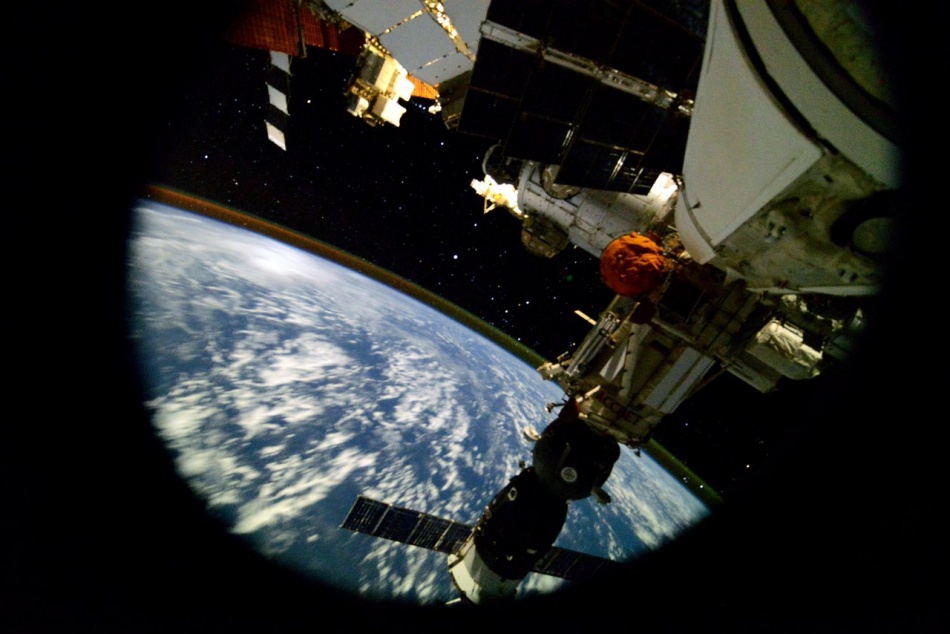
On August 28, the popular science lecture “The Beauty of Space” was held in the Ufa anticafe “GoodZone”. And I want to bring to your attention the adaptation of the lecture to Habrapublication, as well as a short story about the technical aspects and software that was used in the preparation and display.
The origins of the idea
If you want to immediately go to the presentation materials and not read about its origin and technical aspects, click here .
There is such a wonderful person - Alexander Shaenko - a space technology developer who created the community “Your space sector” and gives popular science lectures on space exploration. Initially, lectures were given in Moscow, but in the summer, Alexander had the idea to travel across Russia from Moscow to Kamchatka, giving lectures along the way. Just the other day, the project "Space from Sea to Sea" was successfully completed in the village of Vulkannoe near Petropavlovsk-Kamchatsky.
I learned about this project by accident when Alexander was already in Yekaterinburg. In addition, Ufa, in any case, was not in terms of movement. It seemed to be upset - the lectures passed us. On the other hand, it occurred to me to give a similar lecture on my own. Still, I write popular science publications in Habr, and I worked as a teacher for a long time, lecturing is a familiar and familiar thing. I contacted Alexander, he not only did not mind, but also offered to take his lectures in the public domain as a base. The first lecture should have a minimum entry threshold, so the theme "The Beauty of Space" turned out to be very suitable. I processed the material quite strongly, removing quotes from science fiction works and expanding the direction of the narrative - instead of moving “from space to Earth”, it turned out “from Earth to space”.
Technical aspects
I have not made a presentation for a long time, so the possibility of adding a video has become some news for me. Talking about beauty goes well with the video, so that was good news.
The next was the issue of playing the presentation. Putting a trained person at the computer and commanding him: “Next slide, please” is still inconvenient. Ideally, the presenter should be able to independently switch to any slide in the presentation. At the same time, it is better for the speaker to stand, so the option of sitting at the computer and pressing buttons while controlling the presentation is also bad. Therefore, I spent some time exploring the possibilities of managing presentation from a smartphone, since the large screen and high performance of the Galaxy Note 3 made this idea very promising.
The first idea of managing a presentation device directly from a smartphone was unsuccessful. The manufacturer's promised ability to wirelessly synchronize the screens of a smartphone and a TV crashed about the lack of TVs compatible with this technology. The idea of wire communication required an HDMI adapter, not to mention the inconvenience of a wired connection for a gesturing and moving lecturer. The same problems applied to projectors. The situation was aggravated by software problems - the smartphone has good software that supports video in the presentation (POLARIS Office Viewer, included in the base software), which, however, could not play ODP presentations. And the attempt to export ODP presentations to PPTX led to the fact that the video from them disappeared.
In the process of finding software that could handle the task, I came across software"LibreOffice Impress Remote" from the developers of LibreOffice, which makes the phone a remote control for a computer with a presentation. This option turned out to be the best - the computer connects to the projector, and the smartphone connects via WiFi or Bluetooth to the computer and controls the presentation. A bonus is the ability to display notes on the smartphone screen as tooltips for demonstrations and emulation pointers. According to the results of the lecture, I am satisfied with the chosen way of showing.
The only problem that popped up was the high demands on computer resources. The presentation with the video turned out to be about 500 MB, and inexplicable freezes, glitches and crashes fell on a weak computer. On a more powerful computer used for the lecture, the error appeared only once, just in time to announce a break.
I hope my experience will be useful in creating your presentations.
Beauty of space
Space has firmly entered our lives. Satellites provide communications, TV, Internet, navigation, Earth sensing. On the ISS, the crew moves science forward and helps the national economy. Automatic interplanetary stations provide us with information about what is happening on other planets. But besides all this, space is also beautiful. Space technology is beautiful with engineering excellence. On the ISS, satellites, and AMS are cameras that give us the opportunity to look at space beauty.
Rockets
It seems to be the usual launch of an ordinary Soyuz launch vehicle. If you don’t think about the fact that at the start thirty-two combustion chambers work synchronously, operating at a temperature from which the metal melts, and only special engineering solutions protect the engines from destruction. The nine-minute control system maintains an unstable balance (try holding the pencil vertically on your finger for nine minutes!) And, offline, relying on data on acceleration and rotation angles, provides the highest accuracy (try closing your eyes, drive nine minutes by car and drive into the garage 0.5 cm larger than your car!).
And in the next video, the cameras were put on a rocket of the same type, for the first time in 57 years of flying R-7 launch vehicles. The separation of the four side blocks of the first stage and the opening of the drainage valve of the third stage after separation looks very beautiful.
In general, in space almost any emission of liquid or gas looks very beautiful. And in the event that the rocket is illuminated by the Sun, and the observer on the surface is already in the shadow, it turns out beauty to the whole sky. This effect is called "jellyfish." Image source - AstoForum .

Pay attention to the transverse strip - this is a trace of the separation of the second and third steps.
The third video of the Rocket chapter was also shot from the board of a take-off space ship, but now it is the Space Shuttle.
Haze in the region of 45 seconds of flight is the effect of switching to supersonic sound - air forms a shock wave, behind which pressure drops sharply, and air moisture condenses into fog.
In orbit of the earth
The earth looks very beautiful from orbit. Here is a video from the ISS showing cities at night, northern lights, lightning in thunderstorms:
In general, you can watch endlessly on photos from the ISS. The main problem of this part of the presentation was to refrain from too many photos. Photo source - VK page of Roscosmos .
ISS:

Storm Front:
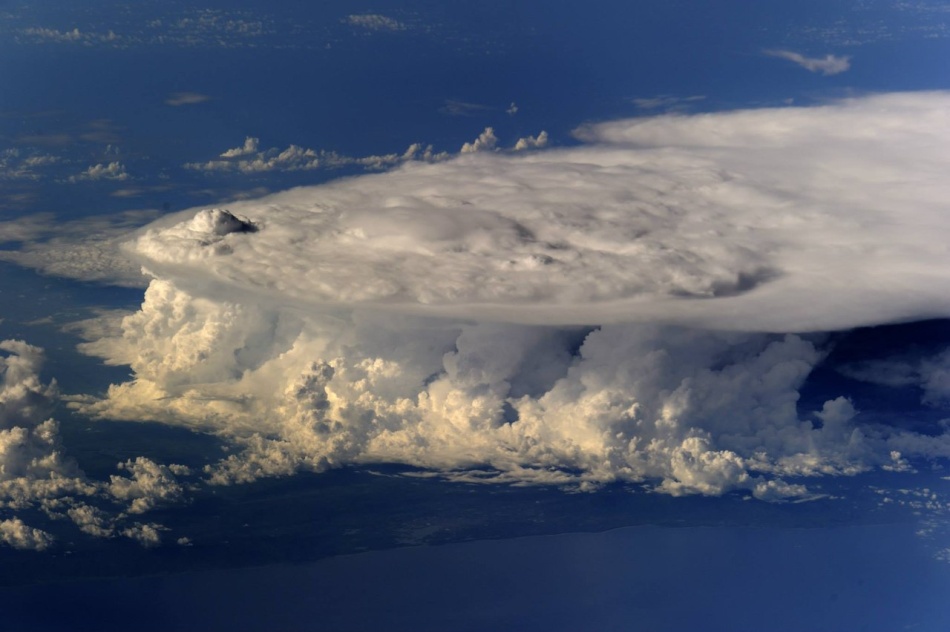
Clouds:

Soyuz spacecraft:

Africa:
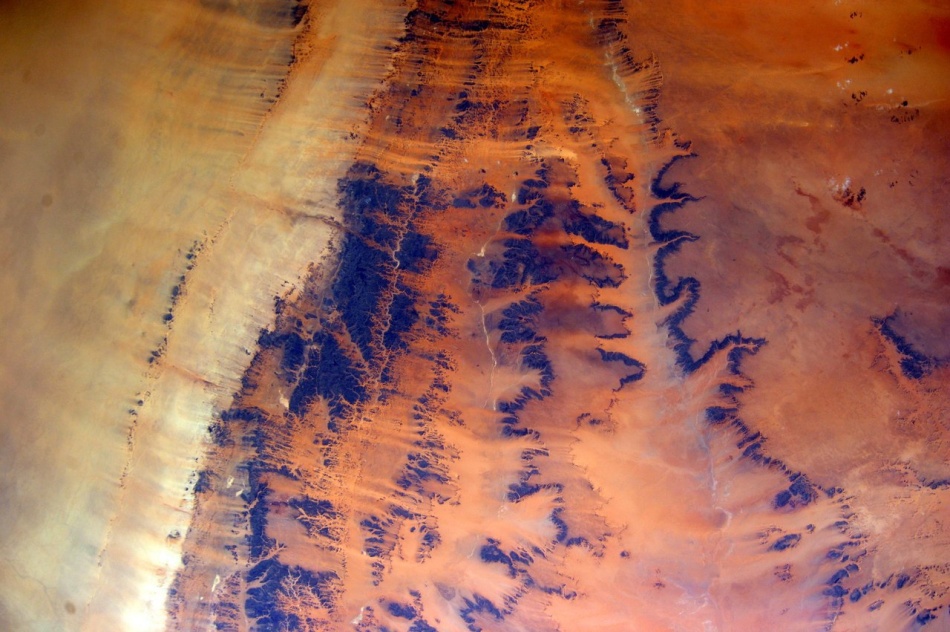
Bering Sea:

Volga:
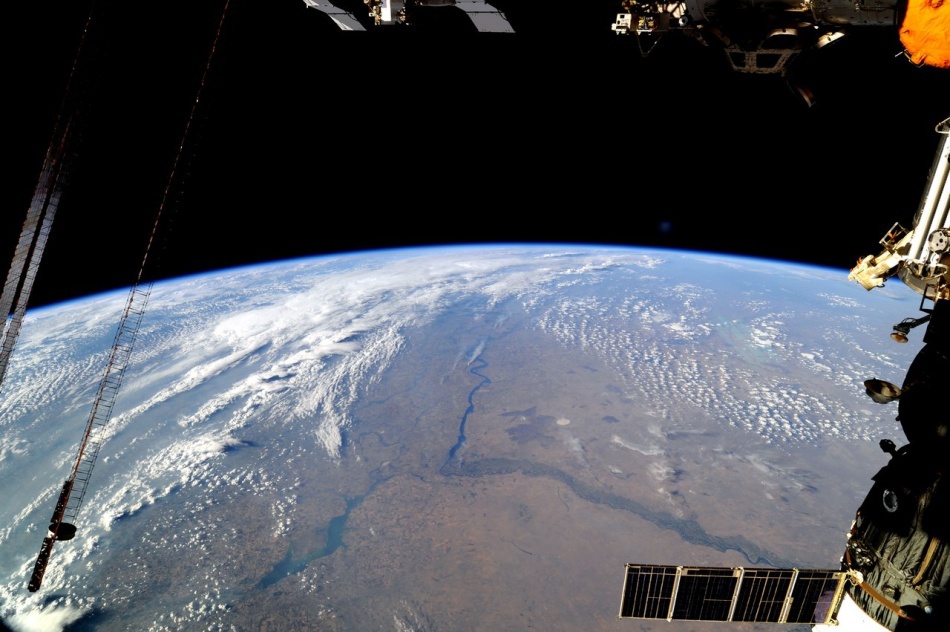
Moon

This is the famous photograph "Earth Rise", taken by astronauts "Apollo 8" December 24, 1968. Paradoxically, but, flying to the moon, we discovered the Earth. And thanks to the Lunar Reconnaissance Orbiter probe , which has been in the orbit of the Moon since 2009, we can look at the reconstruction of this event:
And the next video is a stabilized survey of Apollo 16 astronauts. The camera was located on the chest of the spacesuit on a rather rigid mount, so the original video shook violently, but thanks to modern software we can see a much more comfortable picture of trips on a lunar car :
Mars
Now there is a very active “movement” of robots on Mars - three orbital vehicles, two rovers, and two more vehicles on approach. And thanks to the Mars Reconnaissance Orbiter probe, we can admire alien beauties:
Victoria Crater, one of the goals of the Opportunity rover .

And this sight is impossible in terrestrial conditions. Photographed the circumpolar region of Mars in spring. The snow from carbon dioxide melts and turns immediately into gas, bypassing the liquid phase. Gas emissions capture the soil, brown “panicles” in the photograph are emissions of gas geysers.

The following video shows the technically very complex landing process of the Curiosity rover . The video is stabilized by software processing, which greatly enhances the viewing convenience.
And this is a sunset on Mars. Because of the dust in the atmosphere, it is blue. It seems to be a trifle, but impressive.
Beyond the orbit of Mars
Fresh shots of comet Churyumov-Gerasimenko shot by Rosetta
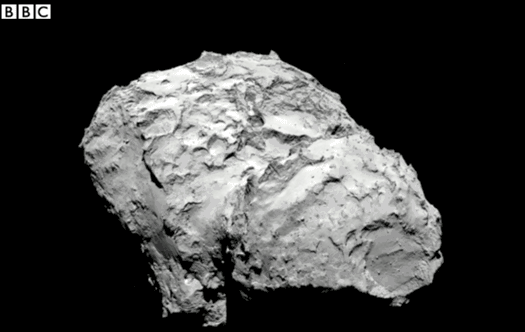
probe. And this is a unique landing of the Huygens probe on Titan. Titan is the largest satellite of the Saturn system, the only one of all the satellites of the solar system covered by an opaque atmosphere. Only the lander could say that there on the surface:
Landing reconstruction, you can get an idea of what the landing machine looks like:
A large red spot on Jupiter, a giant vortex larger than the Earth, a survey of the Voyager 1 :
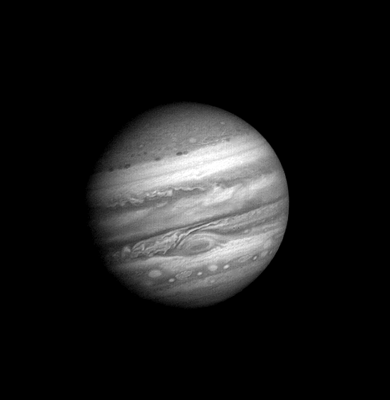
Hexagonal vortex on Saturn. It was reproduced on Earth: rotating rings were placed in a thirty-liter container with rotating water. At different ring speeds, oval, triangular, hexagonal, etc., were obtained. whirlwinds.
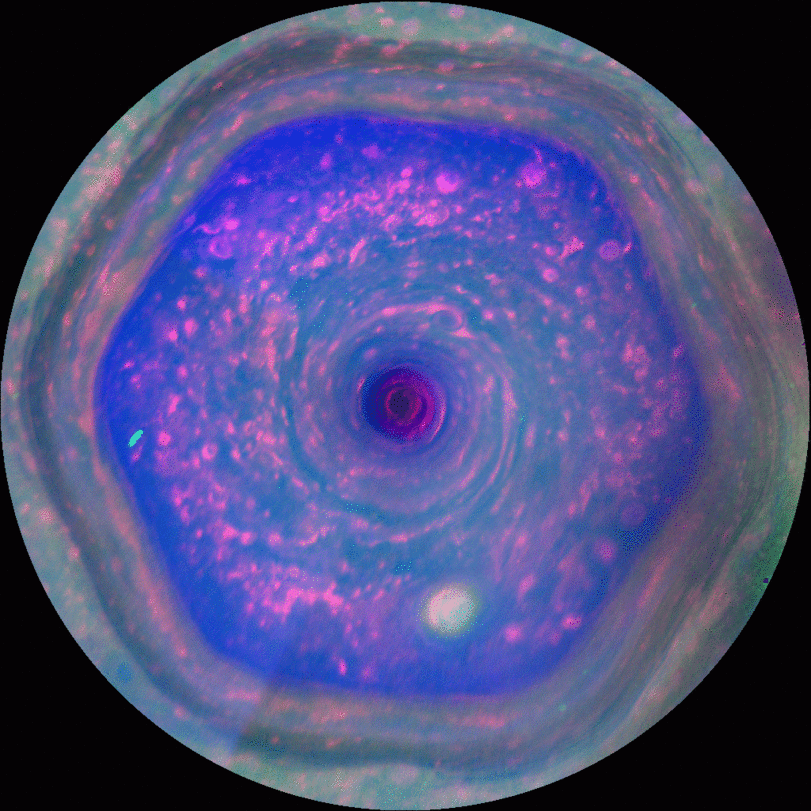
Video from photos of Voyagers and Cassini probes :
What next?
This video is fantastic. But still I want to hope that at least our descendants will see similar pictures from interstellar probes or manned spaceships. There is a phrase Tsiolkovsky very often repeated in conversations about cosmonautics, it is very well-worn, but you still can’t say better: “Earth is the cradle of humanity, but you cannot live forever in the cradle.”
Materials from the lecture
A couple of photos:
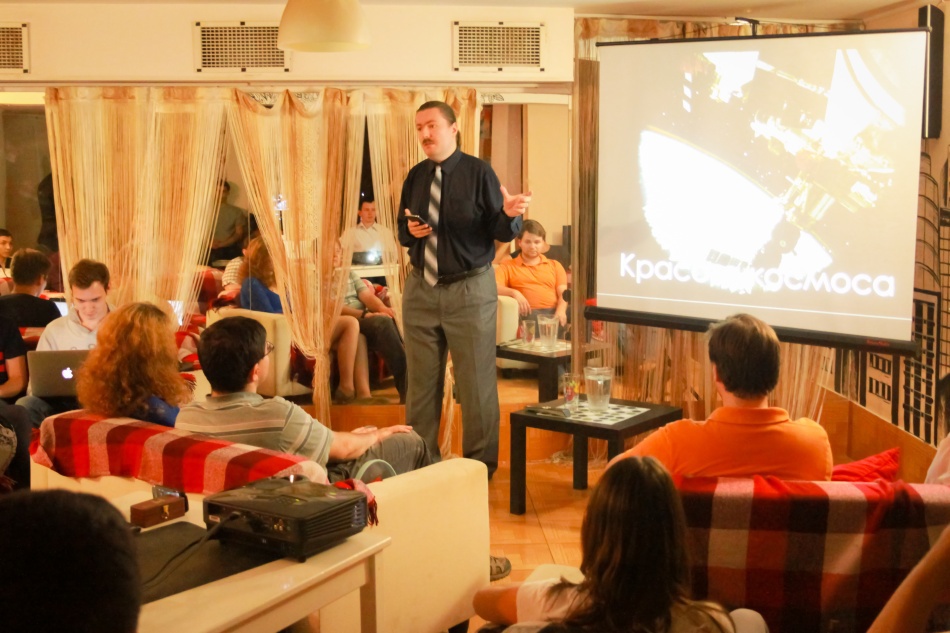
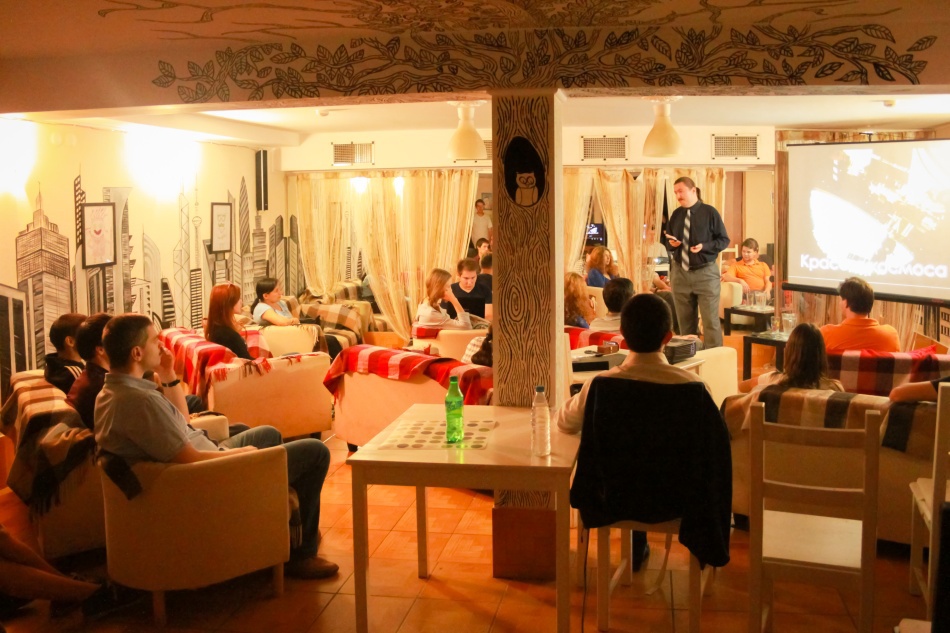
Link to the presentation. Use for popular science lectures is strongly encouraged .
Link to the presentation of Alexander Shaenko (also available for use) .
Video of the first part of the lecture. Unfortunately, the second part was not recorded for unknown reasons. There are some chances for materials from another device that also recorded.
After the lecture, feedback forms were handed out. 22 forms were filled out (there were about thirty people at the lecture), an assessment of the content of the lecture was 4.54 out of 5, an assessment of the form of the lecture (presentation of the material) was 4.59. Judging by the reviews, the audience liked it, and there were repeatedly requests to continue this undertaking.
Special thanks to the GoodZone anticafe , which made the audience free to attend the lecture.
UPD : There was a video from the second device. And the quality is better and the lecture is almost complete.
